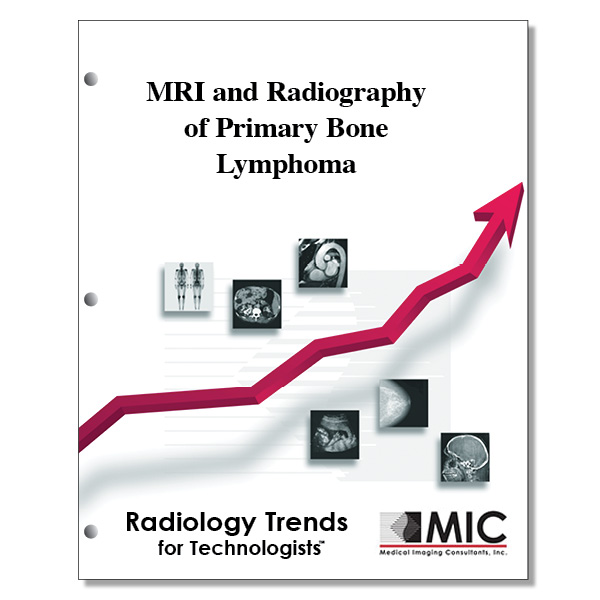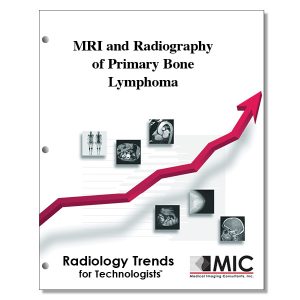

MRI and Radiography of Primary Bone Lymphoma
A review of the roles of MRI and conventional radiography in evaluating Primary Bone Lymphoma.
Course ID: Q00069 Category: Radiology Trends for Technologists Modalities: MRI, Nuclear Medicine, Radiography2.0 |
Satisfaction Guarantee |
$24.00
- Targeted CE
- Outline
- Objectives
Targeted CE per ARRT’s Discipline, Category, and Subcategory classification:
[Note: Discipline-specific Targeted CE credits may be less than the total Category A credits approved for this course.]
Computed Tomography: 1.00
Procedures: 1.00
Head, Spine, and Musculoskeletal: 1.00
Magnetic Resonance Imaging: 2.00
Patient Care: 1.00
Patient Interactions and Management: 1.00
Procedures: 1.00
Neurological: 0.50
Musculoskeletal: 0.50
Nuclear Medicine Technology: 2.00
Patient Care: 1.00
Patient Interactions and Management: 1.00
Procedures: 1.00
Other Imaging Procedures: 1.00
Radiography: 2.00
Patient Care: 1.00
Patient Interactions and Management: 1.00
Procedures: 1.00
Head, Spine and Pelvis Procedures: 0.50
Extremity Procedures: 0.50
Registered Radiologist Assistant: 2.00
Procedures: 2.00
Musculoskeletal and Endocrine Sections: 1.00
Neurological, Vascular, and Lymphatic Sections: 1.00
Radiation Therapy: 2.00
Patient Care: 1.00
Patient and Medical Record Management: 1.00
Procedures: 1.00
Treatment Sites and Tumors: 1.00
Outline
- Introduction
- Clinical & Histologic Features
- Clinical Characteristics
- Histropathologic Characteristics
- Radiographic Charateristics
- Lytic-Destructive Pattern
- Subtle or “Near-Normal” findings
- MR Imaging Characteristics
- Soft Tissue Involvement
- Coritcal Erosion
- Differential Diagnosis
- Treatment
- Conclusions
Objectives
Upon completion of this course, students will:
- understand the characteristics of primary bone lymphoma
- be familiar with the alternate names for PBL.
- know the frequency of occurrence of PBL
- understand what age groups most patients diagnosed with PBL are in
- be familiar with the most common affected site for PBL
- understand those areas NOT commonly affected by PBL
- know what radicular symptoms indicate regarding PBL
- understand the signs of PBL
- know what bone involvement of disseminated malignant lymphoma means
- understand how nodal disease is involved in the diagnosis of PBL.
- understand how disseminated disease is involved in the diagnosis of PBL.
- know the lineage of cells that PBL is made up of
- be familiar with the types of cells PBL could be made up of
- know during which decade the criteria for diagnosis PBL were initially suggested
- understand what period of time lymphoma in a bony site with no evidence of disease elsewhere suggests
- be familiar with the factors that are necessary to rule out a diagnosis of PBL
- understand how PBL appears on various imaging modalities
- know the most common X-ray appearance of PBL
- understand what small elongated rarefactions parallel to the long axis of the bone characterize
- understand what medium and large patches of radiolucency characterize
- understand the clinical implications of a lytic pattern
- understand the clinical implications of a sudden interruption in the continuity of the cortex
- know which imaging modalities best demonstrate an interruption of the cortex
- be familiar with the imaging modalities that can demonstrate sequestra findings
- be familiar with the frequency of occurrence of periosteal reaction
- understand how the appearance of PBL on radiographs may differ striking from on MR
- compare the sensitivity of MR and scintigraphy
- know which MR pulse sequence demonstrates marrow changes best
- be familiar with the appearance of PBL on various MR images
- understand the appearance of reactive marrow on T2-weighted images
- know the appearance of fibrosis
- be familiar with the appearance of STIR images
- understand the relationship between a permeative pattern and other symptoms of PBL
- know on which imaging modalities cortical erosion can be demonstrated
- be familiar with the possible differential diagnoses of PBL
